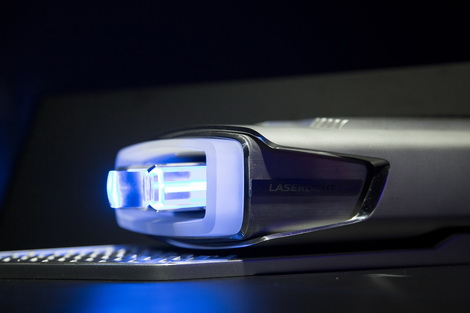Last week I was lucky enough to be invited into the inner sanctums of one of Audi's R&D laboratories in Ingolstadt. The premise was to look at some of the new lighting technology that Audi is working on, in particular its new laser headlight that will feature as an option on the new R8 sports car. The system is very similar to that featured in the limited-run R8 LMX - a model that was released essentially to beat the BMW i8 to the title of having the world's first series production model with laser headlights.
The new headlights each contain a laser module that consists of four laser diodes, each only three-tenths of a millimetre in diameter, which emit a blue laser beam. This then passes through a phosphor element that converts it into white light with a colour temperature of 5,500 Kelvin. It only becomes active at speeds of 60km/h and above in order to prevent thermal build-up, but is capable of distributing light along much greater distances - Audi claims it can reach almost double that of its best current LED unit. Impressive, but it is also likely to be an expensive option, especially if BMW's pricing is anything to go by; it currently charges €11,073.30 to add its own laser headlights to the i8.
Where things got more interesting was the glimpse we got into where Audi plans to take lighting in the next few years. Already, the company is known for its distinctive lighting signature through the LED daytime running lights. Moving this on to the next level will be Audi's use of Organic Light Emitting Diode (OLED) technology, which it will use in both front and rear light units to bring a more three-dimensional appearance to its cars' lights. OLEDs are ultra-thin lighting elements made up of an organic paste just a few thousandths of a millimetre thick that is sandwiched between two highly polished glass panels. When an electric charge passes through the organic material, the microscopic molecular chains react by emitting photons causing the surface to light up.
Initially only red OLED panels had been developed, but Audi has now also developed white and amber OLEDs, although there are cost differences in creating the various colours. Along with Phillips, its technology partner, Audi is currently developing both flat and curved OLEDs, the latter being a breakthrough development, for planned use in production models within the next three years. There are limitations as to how OLEDs can be used however. The organic material inside can only withstand temperatures up to 80 degrees Celsius and the amount of light emitted by them is not strong enough to be used as a functioning brake light, so they will be more aesthetic than functional.
It is believed that these OLEDs will be used in rear lights in order to create a greater visual impact, something that has already been shown on the stunning Prologue concept unveiled last year. There are more detailed and intricate uses for OLED technology further down the line, one of which is in headlight units. Called Network OLED Lighting, this was displayed in a working prototype form demonstrating a latticework of lighting elements that incorporated a daytime running light, main beam and dynamic indicator in a network that can offer a multitude of different lighting appearances in the one unit.
Perhaps the most interesting piece of lighting technology shown to us was Audi's Matrix Laser headlights that are currently in development. They are based on the same principle as the existing Matrix Beam LED headlights that are currently available on a number of models, and use up to 50 individual LED light points that are electronically controlled to shift light dynamically around in order to keep other vehicles free from glare. It is an impressive system that we have witnessed in the real world and it really does work.
Laser Matrix moves this principle on to a completely new level though. It does this with the use of a Digital Micromirror Device (DMD) made up of 420,000 mirrors, each just a few hundredths of a millimetre in length. By using electrostatic fields, each of these micro-mirrors can be controlled and tilted up to 5,000 times per second. The result of which is a dynamic spread of light that is like nothing else, and means only the glazed areas of other vehicles can be dynamically unlit resulting in higher levels of illumination over the entire road ahead. The technology also gives Audi the ability not only to illuminate the road but also to project images onto the road ahead. Applications of this 'targeted light' include projecting the car's wheel tracks onto road surfaces to help the driver stay in their lane, for example, when going through construction zones. In the case of the future of Piloted Driving, these headlights could also prompt planned lane and direction changes to the occupants in order to keep them informed of the autonomous car's driving.
There's a safety aspect to these lights too; important road signs can be highlighted through increased illumination, whilst in urban areas the car could even project a virtual pelican crossing in front of the car to signal to pedestrians when it is safe to cross in front of it. On-board cameras could even detect on-coming cars and project a 'STOP' symbol onto the road in front of the pedestrians to alert them of the impending danger.
Although Matrix Laser headlights may still be some years away, Audi assures us that we won't have to wait as long before its cars begin to feature OLEDs, while Laser headlights will be here this year, along with that very tasty-looking R8.

